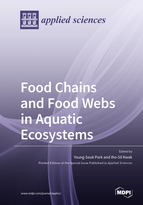Food Chains and Food Webs in Aquatic Ecosystems
A special issue of Applied Sciences (ISSN 2076-3417). This special issue belongs to the section "Environmental Sciences".
Deadline for manuscript submissions: closed (15 February 2020) | Viewed by 25796
Special Issue Editors
Interests: ecological modeling; community ecology; ecosystem monitoring and assessment; invasion biology; aquatic ecosystem management
Special Issues, Collections and Topics in MDPI journals
Interests: biological stress response; molecular biomarker; food chain flow; benthos; chironomids; ecotoxicology; benthos risk assessment
Special Issues, Collections and Topics in MDPI journals
Special Issue Information
Dear Colleagues,
The current Special Issue will focus on food chains and food webs in aquatic ecosystems. Food chains and food webs describe the structure of communities and their energy flows. Recently, diverse methods have been developed for both experimental studies and theoretical/computational studies. They improve our fundamental ecological knowledge and are effectively used for various applications, including the monitoring and assessment of ecosystems. In particular, ecological monitoring and assessment have advanced in the last decades. Along with the progress of molecular and environmental DNA techniques, the process of monitoring and assessment has become rapid and accurate. A wide variety of ecological disturbances associated with temperature and salinity changes and other environmental factors are being recognized as threats to the food-chain functions of freshwater and marine ecosystems.
The current Special Issue will introduce various applications of new techniques and approaches for the study of food chains and food webs in aquatic ecosystems, covering ideas, concepts, methods, and policies; general experimental and computational studies are also welcomed.
Prof. Dr. Young-Seuk PARK
Prof. Dr. Ihn-Sil Kwak
Guest Editors
Manuscript Submission Information
Manuscripts should be submitted online at www.mdpi.com by registering and logging in to this website. Once you are registered, click here to go to the submission form. Manuscripts can be submitted until the deadline. All submissions that pass pre-check are peer-reviewed. Accepted papers will be published continuously in the journal (as soon as accepted) and will be listed together on the special issue website. Research articles, review articles as well as short communications are invited. For planned papers, a title and short abstract (about 100 words) can be sent to the Editorial Office for announcement on this website.
Submitted manuscripts should not have been published previously, nor be under consideration for publication elsewhere (except conference proceedings papers). All manuscripts are thoroughly refereed through a single-blind peer-review process. A guide for authors and other relevant information for submission of manuscripts is available on the Instructions for Authors page. Applied Sciences is an international peer-reviewed open access semimonthly journal published by MDPI.
Please visit the Instructions for Authors page before submitting a manuscript. The Article Processing Charge (APC) for publication in this open access journal is 2400 CHF (Swiss Francs). Submitted papers should be well formatted and use good English. Authors may use MDPI's English editing service prior to publication or during author revisions.
Keywords
- Food chains
- food webs
- computational studies
- models
- monitoring
- assessment
- environmental DNA (eDNA)







